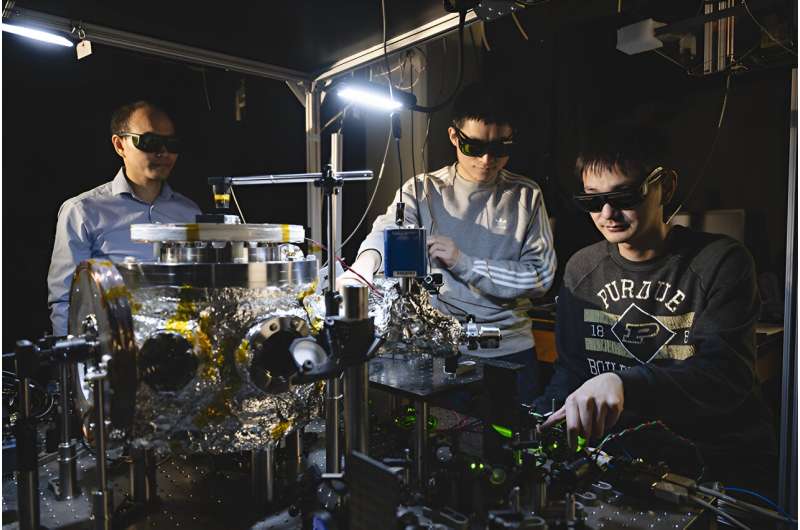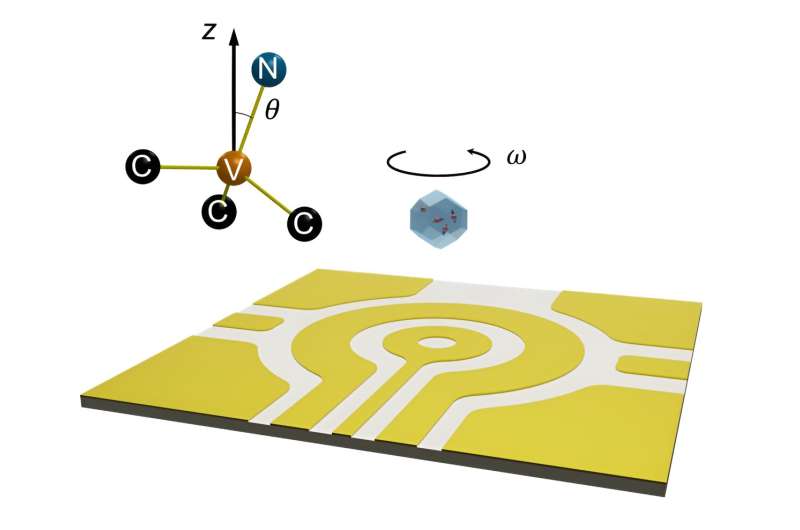This article has been reviewed according to Science X's editorial process and policies. Editors have highlighted the following attributes while ensuring the content's credibility:
fact-checked
peer-reviewed publication
trusted source
proofread
Physicists throw world's smallest disco party with a levitating ball of fluorescent nanodiamond

Physicists at Purdue are throwing the world's smallest disco party. The disco ball itself is a fluorescent nanodiamond, which they have levitated and spun at incredibly high speeds. The fluorescent diamond emits and scatters multicolor lights in different directions as it rotates. The party continues as they study the effects of fast rotation on the spin qubits within their system and are able to observe the Berry phase.
The team, led by Tongcang Li, professor of Physics and Astronomy and Electrical and Computer Engineering at Purdue University, published their results in Nature Communications. Reviewers of the publication described this work as "arguably a groundbreaking moment for the study of rotating quantum systems and levitodynamics" and "a new milestone for the levitated optomechanics community."
"Imagine tiny diamonds floating in an empty space or vacuum. Inside these diamonds, there are spin qubits that scientists can use to make precise measurements and explore the mysterious relationship between quantum mechanics and gravity," explains Li, who is also a member of the Purdue Quantum Science and Engineering Institute.
"In the past, experiments with these floating diamonds had trouble in preventing their loss in vacuum and reading out the spin qubits. However, in our work, we successfully levitated a diamond in a high vacuum using a special ion trap. For the first time, we could observe and control the behavior of the spin qubits inside the levitated diamond in high vacuum."
The team made the diamonds rotate incredibly fast—up to 1.2 billion times per minute! By doing this, they were able to observe how the rotation affected the spin qubits in a unique way known as the Berry phase.
"This breakthrough helps us better understand and study the fascinating world of quantum physics," he says.
The fluorescent nanodiamonds, with an average diameter of about 750 nm, were produced through high-pressure, high-temperature synthesis. These diamonds were irradiated with high-energy electrons to create nitrogen-vacancy color centers, which host electron spin qubits.
When illuminated by a green laser, they emitted red light, which was used to read out their electron spin states. An additional infrared laser was shone at the levitated nanodiamond to monitor its rotation. Like a disco ball, as the nanodiamond rotated, the direction of the scattered infrared light changed, carrying the rotation information of the nanodiamond.

The authors of this paper were mostly from Purdue University and are members of Li's research group: Yuanbin Jin (postdoc), Kunhong Shen (Ph.D. student), Xingyu Gao (Ph.D. student) and Peng Ju (recent Ph.D. graduate). Li, Jin, Shen, and Ju conceived and designed the project and Jin and Shen built the setup.
Jin subsequently performed measurements and calculations and the team collectively discussed the results. Two non-Purdue authors are Alejandro Grine, principal member of technical staff at Sandia National Laboratories, and Chong Zu, assistant professor at Washington University in St. Louis. Li's team discussed the experiment results with Grine and Zu who provided suggestions for improvement of the experiment and manuscript.
"For the design of our integrated surface ion trap," explains Jin. "We used a commercial software, COMSOL Multiphysics, to perform 3D simulations. We calculate the trapping position and the microwave transmittance using different parameters to optimize the design. We added extra electrodes to conveniently control the motion of a levitated diamond. And for fabrication, the surface ion trap is fabricated on a sapphire wafer using photolithography. A 300-nm-thick gold layer is deposited on the sapphire wafer to create the electrodes of the surface ion trap."
So which way are the diamonds spinning and can they be speed or direction manipulated? Shen says yes, they can adjust the spin direction and levitation.
"We can adjust the driving voltage to change the spinning direction," he explains. "The levitated diamond can rotate around the z-axis (which is perpendicular to the surface of the ion trap), shown in the schematic, either clockwise or counterclockwise, depending on our driving signal. If we don't apply the driving signal, the diamond will spin omnidirectionally, like a ball of yarn."
Levitated nanodiamonds with embedded spin qubits have been proposed for precision measurements and creating large quantum superpositions to test the limit of quantum mechanics and the quantum nature of gravity.
"General relativity and quantum mechanics are two of the most important scientific breakthroughs in the 20th century. However, we still do not know how gravity might be quantized," says Li. "Achieving the ability to study quantum gravity experimentally would be a tremendous breakthrough. In addition, rotating diamonds with embedded spin qubits provide a platform to study the coupling between mechanical motion and quantum spins."
This discovery could have a ripple effect in industrial applications. Li says that levitated micro and nano-scale particles in vacuum can serve as excellent accelerometers and electric field sensors. For example, the US Air Force Research Laboratory (AFRL) are using optically-levitated nanoparticles to develop solutions for critical problems in navigation and communication.
"At Purdue University, we have state-of-the-art facilities for our research in levitated optomechanics," says Li. "We have two specialized, home-built systems dedicated to this area of study. Additionally, we have access to the shared facilities at the Birck Nanotechnology Center, which enables us to fabricate and characterize the integrated surface ion trap on campus. We are also fortunate to have talented students and postdocs capable of conducting cutting-edge research. Furthermore, my group has been working in this field for ten years, and our extensive experience has allowed us to make rapid progress."
More information: Yuanbin Jin et al, Quantum control and Berry phase of electron spins in rotating levitated diamonds in high vacuum, Nature Communications (2024). DOI: 10.1038/s41467-024-49175-3
Journal information: Nature Communications
Provided by Purdue University





















